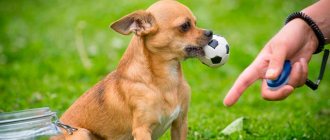Why do you need to train a dog?
Animals, especially dogs, not only can, but also need to be trained. The need for this arises not only among professional breeders or dog handlers who decide to train a dog to search for traces or certain odors, but also among ordinary citizens. Training helps:
- make the dog more obedient, pacify its tough temper (animals are very different, but discipline helps to cope with their unpleasant character traits);
- socialize the animal, improve its mental state;
- improve the dog’s guarding or hunting qualities;
- reduce the level of aggression towards humans and other animals.
Important! Pets are not always trained for the purposes outlined above; sometimes training helps them develop and consolidate certain playing skills. Dogs are often trained to perform all sorts of tricks for the enjoyment of the family or for display to the public.
Training a service dog to command “Toe” or “Nearby”
Auxiliary items
The key to good training is the correct choice of equipment. Here is the minimum set of auxiliary items that every dog breeder who trains his pet should have:
- training bag, feeding bag, bag for treats - this element of equipment is called differently, but the essence is the same - it contains a treat;
- regular and strict (metal) collars;
- short (1-1.5 m) and long (10-12 m) leashes;
- muzzle,
- the grip – also called a “rope” – plays the role of a conditional opponent, towards whom the dog’s teeth are redirected;
- noose, or ringovka - recommended for training with adult animals as part of a physical approach to training; it is better to purchase models with a lock, as they allow you to attach the noose to the desired area of the neck;
- a dumbbell is a surrogate substitute for hunted game, which the dog must fetch on the command “Fetch”, and then give to the trainer on the command “Give”; without a command, the dog should not react to a thrown dumbbell and pick it up from the ground.
A strict collar is used to train dogs that are not sensitive enough to normal painful stimuli. It is also recommended to purchase several toys to train your dog. The best options are an Arabian ball, a puller and a regular rope.
Is it possible to train an adult dog?
Dogs begin to be trained at a fairly early age, but even an adult dog can be taught some useful things, for example, not to steal food from the table, go to the toilet in a certain place, fetch a stick or slippers, and take a stance.
An adult dog will resist any attempts to change his behavior more than a puppy. But attention to detail and perseverance make it possible to turn a completely untrained sexually mature individual into a completely mannered and even noble one at first glance.
Train the dog yourself or contact a dog trainer
Puppies can be trained on their own, but adult dogs need a stronger will than their owner. Accustomed to a certain behavior towards him on the part of a person, he simply will not perceive the commands correctly. It is rare that a dog can be trained independently after it has reached the age of 1-2 years.
The help of a dog handler will undoubtedly be required. But here you need to take into account exactly what requirements the dog owner places on the pet, what he wants to teach it. So, if the task is solely to teach your pet the rules of catching a plate or giving a paw, then you can cope with this yourself, but important commands for each dog should still be taught by a professional.
Obedient, trained dog
"Bite" to explain something
Until you became its owner, the dog was commanded by the mother. To deal with a disobedient child, the animal world has its own way: the mother bites the puppy in the neck or simply rolls it onto its back.
A person can also use these same methods, but to imitate a bite, you need to tense your fingers and simply hit the neck with the tips, but only from above, where the skin is rougher.
If the behavior has not changed, then throw the naughty person on his back. It is possible that the pet will not understand the first time, but by the third time he will definitely realize that he is to blame.
General rules for self-training
If you still decide not to take your pet anywhere and raise it yourself, you need to write down or remember the following simple rules:
- training should take place in a deserted place, it is better if the owner and dog are left alone;
- commands are given in a firm, confident voice;
- You cannot pet or give treats to a dog that has not completed the assignment;
- you need to train regularly;
- the dog is rewarded for each action performed;
- You cannot shout or hit a dog that has failed to complete the task.
Important! Experts recommend using special incentives for each team. This will help the dog distinguish them not only by hearing, but also by smell or type of action. If food is used as a reward, then there is no need to allow the pet to eat to its fullest after each successfully completed action. There should be little food, literally a few small pieces. As you move forward, the result appears and consolidates, the reward after each completed command is refused.
Basic training methods
Both professionals and amateurs use training methods such as:
- Tasteful. To use it, the dog is not fed for about 3-4 hours straight before the start of training. A half-starved dog happily follows commands, hoping to get a treat or just food at the end of the lesson. Gradually, the dog develops a reflex to food. This method is used for training search engines, dogs in which the food reaction predominates, but is not used for future guard and guard dogs, animals trained with the aim of developing in them a reflex to apprehend criminals.
- Mechanical. The carrot and stick method. During training, the dog is influenced mechanically, for example, by whipping it with a twig, urging it to take action. At the end of the lesson, the dog is petted.
- Contrasting. Combines the two previous methods. Dogs that successfully complete the task are fed, and those that refuse to follow the commands are punished.
- Imitative. A dog imitates an animal or a person. The method is optional.
- Coaching. Using a set of stimuli, conditions are created that encourage the animal to carry out certain commands.
When training at home, it is reasonable to use contrast and taste reward methods, but dog handlers use all of the above. This allows them to achieve their goal faster.
The dog walks nearby, reacting to the owner
Common Mistakes
Not all dogs can be trained to follow the “Voice” command. Some breeds are simply not trainable, such as most hunting dogs. In addition, excessive pressure on the dog can negatively affect his psyche - cause aggression or even illness. If you are unable to train your dog on your own, it is recommended that you contact a professional.
During the training process, it is strictly contraindicated to punish or beat the dog. This can only spoil her character and make her very aggressive. All commands must be pronounced in a calm, even and clear voice, and no anger or dissatisfaction should be heard in the sound of the voice.
Whatever training option is used, we must not forget that a dog is a living, intelligent creature. The dog will happily follow any command if the owner treats him well and with respect.
Commands for initial familiarization
The dog must carry out a number of commands without thinking. They are simple, any dog can master them, be it a huge Caucasian or a small Chihuahua.
Team "Place"
First on the list of useful commands. Allows you to teach your dog to spend time exclusively in a designated corner of the house or to be close to a person in a situation that causes a sharp negative reaction in the dog.
"Give!"
This command is taught according to instructions during feeding, teaching the dog that, if necessary, he is obliged to give the owner any object, including food. To do this, say the command “Give!” and move the bowl away from the dog, which is already trying to feast on its contents.
On a note! You need to act carefully, an adult dog may well bite.
"Sit!" and “Lie down!”
Commands similar to the “Place!” command. They are performed in the same way, training methods are similar. The trainer needs to look at the dog and say in a stern but calm voice, “Sit!”, lightly pulling the leash toward you and pressing the palm of your hand on the croup. When executing the “Lie down” order, light pressure is applied to the back.
"To me!" and “Nearby!”
This command allows you to restrain the aggression of small and large dogs directed at someone outside their own world and the world of its owner, for example, at a stranger - another person or animal.
Command "Stop!"
For a domestic dog (Jack Russell terrier, Yorkshire terrier, Labrador, husky, pug, German shepherd, husky), learning the above commands will be enough, but a dog destined to become a guard or hunter must also learn the “Stop!” command.
Teams "Fu!" and “You can’t!”
With the help of these commands, it is possible to keep the pet from absorbing street garbage or attacking a mongrel or a person in just a few lessons or courses. A smart dog can learn them very quickly.
"Voice!"
If the dog is small or extremely active, it is first of all taught the “Voice!” command. It helps determine the location of a lost pet.
Preparing for training: where to start
In order for dog training to produce positive results, you need proper preparation for the learning process. You should start by preparing the dog.
Recommendations for preparing the animal:
1. Before training, you cannot feed the dog, because after feeding it must rest. In addition, active movements on a full stomach increase the likelihood of volvulus and other gastrointestinal problems. 2. Before training, the owner needs to establish contact with the dog, play with it, and pet it. 3. In order for the dog to fully concentrate on the educational process, you must first let it go to the toilet to satisfy its natural needs. 4. To train a dog on the street, you will need some equipment: a soft leather collar, a leash (length from 1 to 15 meters), a treat for motivation and reward for following commands. Medium and large breed dogs will also need a muzzle.
Basic rules and methods of dog training
There are some rules and training methods that will help novice dog breeders develop all the necessary qualities in their pets.
Basic rules of training:
1. One person should teach the dog commands.
All family members should not be involved in raising a pet. 2. You need to train your dog in a good mood. Negative emotions and irritability of the owner will not allow you to establish friendly contact with the dog and achieve positive results in training. 3. Consider a training program, taking into account the nature of the animal. 4. Training can only be carried out when the dog is in good physical shape. You cannot teach new things to pets that have a lethargic appearance and any health problems. 5. End the training with praise for each success and, of course, do not forget to reward the dog with his favorite treat. She will definitely appreciate it and will look forward to the next lesson. There are many methods of training dogs: guidance, pushing, imitation, playful and defensive behavior, passive flexion, reduction of behavioral act, etc. Such methods are often used by professional dog trainers.
An ordinary dog owner who wants to teach his pet different commands can choose the simplest method of training - motivation with an incentive to perform a certain action, where the motivational element is a tasty treat or the dog’s favorite toy.
The imitation method is relevant for training puppies if the family already has an adult trained dog that will set a good example for the younger generation to follow.
Useful tips from professionals
Experts advise exercising regularly. What is important in this matter are:
- perseverance;
- patience;
- positive attitude;
- the ability to hide negative emotions.
Note! Initially, your pet is unlikely to succeed, but daily work on correcting mistakes will help improve the result.
Training an adult dog from scratch takes a lot of time and effort, since we are talking about animals with already defined character traits, which will not be easy to correct. But the result is worth it.
"Serious" games with puppies
The way we teach a puppy commands determines his future behavior. By the age of 3 months, the baby should clearly know his place in the house and not litter the room.
The main commands for entry-level training are: “Fu”, “Come to me”, “Place”.
The duration of the first workouts should be 15-20 minutes. Gradually, the time can be increased to 40 minutes a day. Long exercises will lead to fatigue and disobedience. To avoid this, you need to take short breaks (5-10 minutes), ending your workouts on time. This applies to students of all ages (especially if adult dogs have not been trained before).
To punish a four-legged friend, a severe reprimand in a dissatisfied voice is enough.











